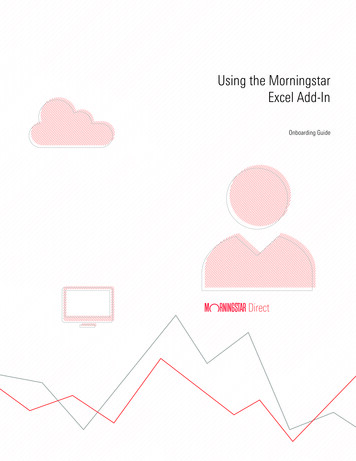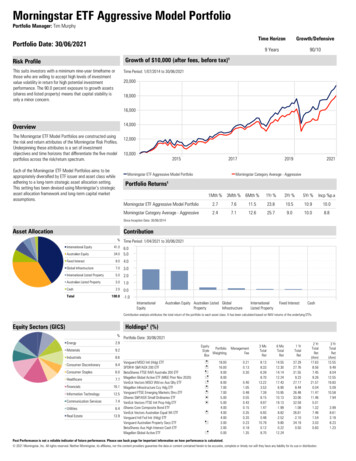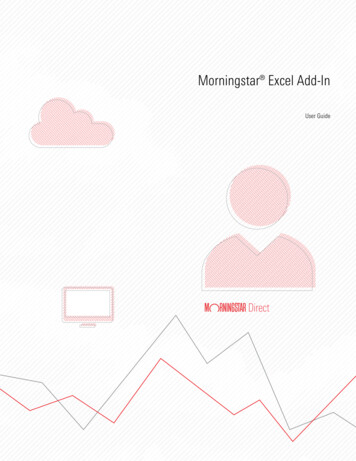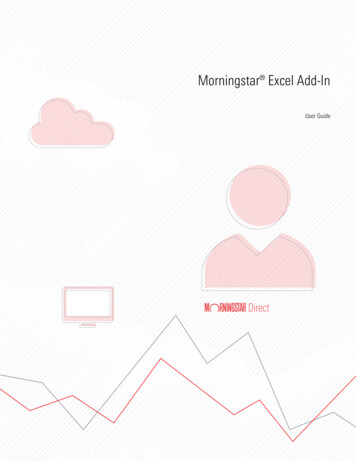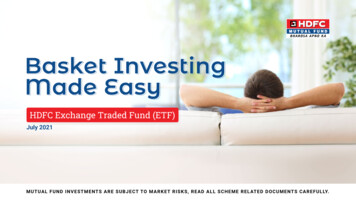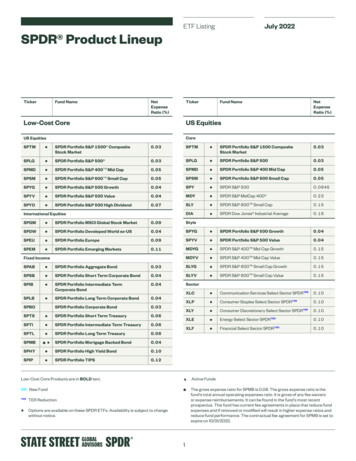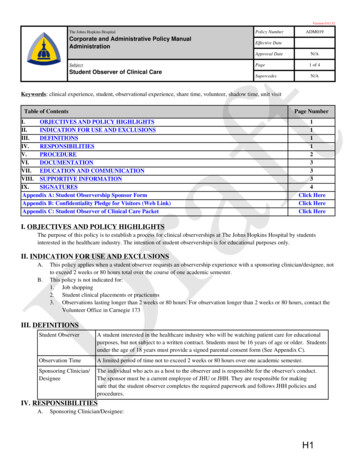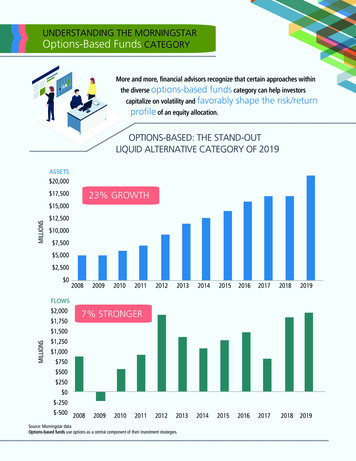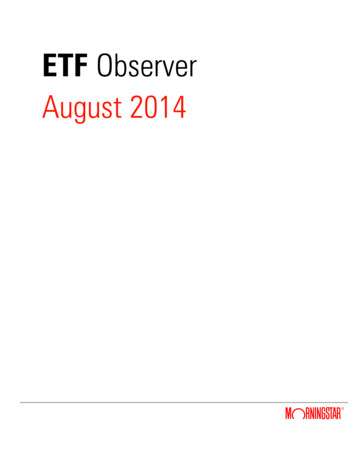
Transcription
ETF ObserverAugust 2014
Morningstar ETF Observer August 2014ContentsStumbling Across the Finish Line1Market Barometer2ETF Assets and Flows4ETF News and Industry Dashboard5Capital Group Bets on a Different Kind of Tech8Hidden Risks in Emerging-Markets Debt?11A Closer Look at the Total Cost of ETP Ownership: Bid-Ask Spreads13A Rough Road for Financial-Services ETFs17Spotlighting a Strategic Beta ETF & the Utilities Sector23ETF Spotlight: First Trust Large Cap Core AlphaDEX (FEX)24ETF Spotlight: Vanguard Utilities ETF (VPU)28 2014 Morningstar, Inc. All rights reserved. The information, data, analyses, and opinions contained herein (1) include the confidential and proprietary information of Morningstar, Inc., (2) may not be copied or redistributed, (3) do not constitute investment adviceoffered by Morningstar, Inc., (4) are provided solely for informational purposes and therefore are not an offer to buy or sell a security, and (5) are not warranted to be correct, complete or accurate. Morningstar, Inc. shall not be responsible for any trading decisions,damages, or other losses resulting from, or related to, this information, data, analyses or opinions or their use.
Morningstar ETF Observer August 2014ETF InsightBen Johnson, CFADirector of Manager ResearchPassive Strategiesben.johnson@morningstar.com 1 312 384 4077Page 1 of 32Stumbling Across the Finish LineThe S&P 500 notched a new all-time high in July before taking a nose dive during the last few trading days ofthe month and finishing 1.38% lower than where it began the third quarter. Some of the hardest hit segmentsof the market such as small caps and utility stocks were also amongst the most richly priced at the month’sonset. The ETF asset flows picture was mixed. U.S. equity and emerging-markets ETFs saw sizable inflows,amassing a respective 9.8 billion and 3.4 billion in new investor capital. Meanwhile, high-yield ETFsexperienced record redemptions of approximately 3.1 billion.The single most significant bit of ETF industry news from the month of July was Capital Group’s filing for nontransparent actively managed ETFs. I share my thoughts on the matter in “Capital Group Bets on a DifferentKind of Tech”. In sum, I see this as a wager on new distribution technology by a firm that has been bleedingassets because its existing distribution model is suffering.This month’s installment of ETF Observer also features three additional articles and two fund spotlights fromour Passive Strategies Research team. In “Hidden Risks in Emerging Markets Debt?” Patty Oey examines theeffect that fickle foreign fund flows (say that five times fast) might have on portfolios of local currencydenominated emerging-markets bonds. Next, Mike Rawson takes a closer look at bid-ask spreads for ETFsand how they affect the math around the total cost of ETF ownership. Bob Goldsborough adds in a detailedexamination of the menu of financial services ETFs, which have lost some momentum after two consecutiveyears of outperforming the S&P 500. This month we put the spotlight on First Trust Large Cap Core AlphaDex(FEX). Mike Rawson argues that, “ the fund provides no discernible edge beyond what is obtained throughtraditional size and value tilts. Those exposures are available more cheaply and transparently through otherfunds.” Lastly, Bob Goldsborough takes a look at the Vanguard Utilities ETF (VPU), a low-cost way to accesswhat our equity analysts believe is currently a pricey sector.Finally, I’d like to once again plug our fifth annual Morningstar ETF Conference. This year’s conference will beheld from September 17-19 at the Chicago Sheraton. You can find additional details and the full conferenceagenda here. This year’s conference is shaping up to be our best yet—owing to a fantastic lineup of speakersand panelists. This year’s keynote and general session speakers include Nobel Laureate Eugene Fama,BlackRock’s Russ Koesterich, JP Morgan’s Dr. David Kelly, PIMCO’s Jerome Schneider, AQR’s Ronen Israel,and Wesley Gray of Drexel University. We hope to see you in Chicago in September for three days packedwith valuable insights and investment ideas.Best, 2014 Morningstar, Inc. All rights reserved. The information, data, analyses, and opinions contained herein (1) include the confidential and proprietary information of Morningstar, Inc., (2) may not be copied or redistributed, (3) do not constitute investment adviceoffered by Morningstar, Inc., (4) are provided solely for informational purposes and therefore are not an offer to buy or sell a security, and (5) are not warranted to be correct, complete or accurate. Morningstar, Inc. shall not be responsible for any trading decisions,damages, or other losses resulting from, or related to, this information, data, analyses or opinions or their use.
Morningstar ETF Observer August 2014Page 2 of 32U.S. Market Barometer1 MonthYTD1 YearPrice/EarningsTime Period: 01/08/2004 to 31/07/201422.520.017.5P/E Ratio (TTM) 08201020122014Price/Book ValueTime Period: 01/08/2004 to 31/07/20143.53.0P/B Ratio (TTM) (Long)2.52.01.51.02004S&P 500 TR USDMSCI EAFE NR USD2006Russell 2000 TR USDMSCI EM NR USDMSCI ACWI NR USD 2014 Morningstar, Inc. All rights reserved. The information, data, analyses, and opinions contained herein (1) include the confidential and proprietary information of Morningstar, Inc., (2) may not be copied or redistributed, (3) do not constitute investment adviceoffered by Morningstar, Inc., (4) are provided solely for informational purposes and therefore are not an offer to buy or sell a security, and (5) are not warranted to be correct, complete or accurate. Morningstar, Inc. shall not be responsible for any trading decisions,damages, or other losses resulting from, or related to, this information, data, analyses or opinions or their use.
Morningstar ETF Observer August 2014Page 3 of 32Market PerformanceTrailing Total ReturnsU.S. Equity Market1 MonthYTD1 Year3 Yr Annlzd5 Yr Annlzd 10 Yr Annlzd 15 Yr AnnlzdS&P 500 TR USD-1.385.6616.9416.8416.798.004.47Wilshire 5000 Total Mkt TR USD-1.855.0216.2816.4216.958.495.18DJ Industrial Average TR USD-1.441.209.3913.8115.547.775.43NASDAQ 100 TR USD1.179.1327.6919.6620.6111.644.24Russell 2000 TR USD-6.05-3.068.5613.5916.568.787.76MSCI ACWI NR USD-1.214.8915.9110.4112.107.684.32MSCI EAFE NR USD-1.972.7215.077.969.407.074.25MSCI EM NR USD1.938.1915.320.407.3412.379.23Global Equity MarketS&P 500 Sectors-1.3Consumer Discretionary-0.712.7-3.2Consumer 40.1Health .528.1-1.9Materials6.623.13.7Telecom ServicesUtilities8.18.8-6.810.69.30.0S&P US REIT Index17.712.1-7.5-5.01 7.530.01 YrTrailing Total ReturnsU.S. Fixed Income Market1 MonthYTD1 Year3 Yr AnnlzdBarclays US Agg Bond TR USD1.956.2210.107.67Markit iBoxx Liquid IG TR USD2.008.8514.29BofAML US HY Master II TR USD0.856.8114.67Morningstar Short-Term US Govt TR2.062.90Morningstar Short-Term Corp TR2.063.88Morningstar Intermediate US Govt TR1.71Morningstar Intermediate Corp TR1.95Morningstar Long-Term US Govt TR5 Yr Annlzd 10 Yr Annlzd 15 Yr 212.7610.426.574.404.86Morningstar Long-Term Corp TR2.1412.1116.9212.239.305.235.51S&P Preferred Stock TR USD1.8213.3415.9012.7110.513.06— 2014 Morningstar, Inc. All rights reserved. The information, data, analyses, and opinions contained herein (1) include the confidential and proprietary information of Morningstar, Inc., (2) may not be copied or redistributed, (3) do not constitute investment adviceoffered by Morningstar, Inc., (4) are provided solely for informational purposes and therefore are not an offer to buy or sell a security, and (5) are not warranted to be correct, complete or accurate. Morningstar, Inc. shall not be responsible for any trading decisions,damages, or other losses resulting from, or related to, this information, data, analyses or opinions or their use.
Morningstar ETF Observer August 2014Top 10 ETF ProvidersTop 15 ETF Inflows in JulyTop 15 ETF Outflows in July 2014 Morningstar, Inc. All rights reserved. The information, data, analyses, and opinions contained herein (1) include the confidential and proprietary information of Morningstar, Inc., (2) may not be copied or redistributed, (3) do not constitute investment adviceoffered by Morningstar, Inc., (4) are provided solely for informational purposes and therefore are not an offer to buy or sell a security, and (5) are not warranted to be correct, complete or accurate. Morningstar, Inc. shall not be responsible for any trading decisions,damages, or other losses resulting from, or related to, this information, data, analyses or opinions or their use.Page 4 of 32
Morningstar ETF Observer August 2014ETF NewsPage 5 of 32Eaton Vance Drafts First 8 ‘ETMFs’Mutual fund manager lays out mandates for the first eight new actively managedfunds in its proposed new structure, which still awaits approval from regulators.On July 30, Eaton Vance EV placed into registration with the SEC its first eight proposed exchange-tradedmanaged funds, or ETMFs.Robert GoldsboroughAnalyst, Passive StrategiesManager Researchrobert.goldsborough@morningstar.com 1 312 384 3997Back in early 2013, Eaton Vance submitted an application to the SEC seeking permission to create a newstructure for actively managed, nontransparent ETFs. Dubbed ETMFs, the proposed funds would mirrorexisting Eaton Vance mutual funds and use Navigate Fund Solutions’ technology, which Eaton Vance acquiredfrom ETF product-development expert and consultant Gary Gastineau.The premise behind the ETMF structure is to employ NAV-based trading in order to allow a fund issuer tomask its portfolio holdings. Eaton Vance views ETMFs as actively managed open-end funds that provide thecost, tax efficiencies, and shareholder protections of ETFs but with the portfolio confidentiality of open-endmutual funds. Under NAV-based trading, funds’ prices vary from NAV by a market-determined premium ordiscount, which could be zero. And even in the absence of full portfolio holdings disclosure, Eaton Vancebelieves that market makers would have the opportunity to earn reliable arbitrage profits on ETMFs, so thefunds would trade at consistently tight spreads to their net asset value.The SEC hasn’t yet ruled on ETMFs. However, that didn’t dissuade Eaton Vance from moving forward withdropping six specific proposed ETMFs into registration with the SEC. The six proposed funds would be namedEaton Vance Bond ETMF, Eaton Vance Floating-Rate & High Income ETMF, Eaton Vance Global MacroAbsolute Return ETMF, Eaton Vance Government Obligations ETF, Eaton Vance High Income OpportunitiesETMF, Eaton Vance 5 to 15 Year Laddered Municipal Income ETMF, Eaton Vance High Yield Municipal IncomeETMF, and Eaton Vance National Municipal Income ETMF.Calamos Rolls Out Actively Managed Growth ETFOn July 14, Calamos launched its first ETF, bringing to market an actively managed fund holding U.S. growthstocks.Calamos Focus Growth ETF CFGE holds firms with market caps exceeding 1 billion. The fund’s managerstake a top-down macroeconomic view and combine it with a bottom-up stock-picking approach that focuseson individual securities’ growth potential, financial strength, and stability.The fund’s managers are John P. Calamos Sr., Gary Black, Nick Niziolek, Jon Vacko, John Hillenbrand, SteveKlouda, and Dennis Cogan. CFGE charges 0.90% and does not mimic the precise style of any specific Calamosopen-end mutual fund.Barclays Debuts ‘Women in Leadership’ ETNOn July 10, Barclays rolled out an exchange-traded note that tracks an index consisting of U.S. companieswith gender-diverse executive leadership and governance.Barclays Women in Leadership ETN WIL is the first exchange-traded product offering exposure to companieswith gender-diverse management, and it’s one of a scant few that employ environmental, social, andgovernance (ESG) screens. The ETN tracks a Barclays index, which takes data compiled by InstitutionalShareholder Services and which requires companies to have either a female CEO or 25% of its board seatsoccupied by women. WIL charges 0.45%. 2014 Morningstar, Inc. All rights reserved. The information, data, analyses, and opinions contained herein (1) include the confidential and proprietary information of Morningstar, Inc., (2) may not be copied or redistributed, (3) do not constitute investment adviceoffered by Morningstar, Inc., (4) are provided solely for informational purposes and therefore are not an offer to buy or sell a security, and (5) are not warranted to be correct, complete or accurate. Morningstar, Inc. shall not be responsible for any trading decisions,damages, or other losses resulting from, or related to, this information, data, analyses or opinions or their use.
Morningstar ETF Observer August 2014Page 6 of 32American Funds/Capital Group Seeks to Enter ETF SpaceOn July 25, the parent company of traditional open-end fund manager American Funds filed paperwork withthe SEC seeking permission to issue actively managed, non-transparent ETFs. Capital Group is seeking to usethe same blind trust structure that has been designed by Precidian and that is being proposed by all otherapplicants also seeking regulatory approval for actively managed non-transparent ETFs. The blind truststructure, which ETF juggernauts BlackRock, State Street, and PowerShares also hope to use, allows theblind trust to effectively behave as an authorized participant, exchanging fund shares and portfolio securitieswith the proposed ETFs and allowing those funds’ shareholders to enjoy the same in-kind tax benefits asother ETF investors. Although the proposed ETFs would display their holdings just once every three months,they also would release their intraday indicative value to the market every 15 seconds with the aim ofkeeping spreads tight.Details in the filing were sparse. Capital Group provided little information about what its first fund would be ifit wins approval to market ETFs using the nontransparent structure, other than that it would be a U.S.oriented equity fund. That’s not surprising, given that that’s where the vast majority of American Funds’assets under management reside. Morningstar gives American Funds a positive Parent rating, and attributesthe firm’s long tenure of investing success to several sources, including the firm’s trademark multimanagersystem, a stable and long-tenured team of professionals, and an incentive system that allows professionals totake a long-term view. In addition, with peer-beating fees, American Funds is ideally suited for the ETFstructure. As of this writing, however, there is little visibility on when the SEC will rule on any fund company’sapplications for permission to market actively managed, non-transparent ETFs.ALPS Launches Sprott Gold Miners ETFOn July 15, ALPS debuted a passively managed ETF that holds U.S.-listed gold and silver mining companies.Sprott Gold Miners ETF SGDM tracks the modified market-cap-weighted Sprott Zacks Gold Miners Index,which contains gold miners with a minimum market cap of 1 billion, although those whose market caps arebetween 400 million and 1 billion are eligible if they have a daily price volume of 800,000. The index ismanaged by Zacks Index Services, which licenses the Sprott name. (Toronto-based Sprott is an alternativeinvestment manager known for its expertise in precious metals and natural resource investing.) And the indexis factor-based, seeking to pick the 25 gold stocks with the highest historical beta to the spot price of gold. Inaddition, the benchmark weights constituents based on year-over-year revenue growth and debt-to-equitylevels. SGDM charges 0.57%.IShares Rolls Out Global REIT ETFIShares on July 10 brought to market a passively managed ETF holding REITs in both developed and emergingmarkets. IShares Global REIT ETF REET tracks a FTSE index and uses a sampling strategy, holding arepresentative sample of the securities from the benchmark that have the same collective investment profileas the entire index. REET charges 0.14%.First Trust Launches International ‘Focus 5’ ETFOn July 23, First Trust debuted another passively managed, fund of funds ETF in its suite of “Focus 5” ETFsthat use a momentum strategy to select ETFs. First Trust Dorsey Wright International Focus 5 ETF IFV tracksan equal-weight index managed by Dorsey, Wright & Associates that scrutinizes First Trust’s sector andindustry ETFs and ranks them using a relative strength methodology based on each fund’s marketperformance and potential for upside, looking for momentum signals by securities. The benchmark thenchooses the five top-ranking First Trust ETFs according to the proprietary relative strength methodology. Theindex is evaluated weekly, and the five positions remain in the index as long as those positions continue tosuggest that they will outperform the majority of the other potential First Trust ETFs on a relative basis. Indexcomponents are only removed if they fall to the bottom half of the universe of First Trust ETFs. IFV charges awhopping 1.10%.In March 2014, First Trust launched a sector-based Focus 5 ETF, First Trust Dorsey Wright Focus 5 ETF FV. 2014 Morningstar, Inc. All rights reserved. The information, data, analyses, and opinions contained herein (1) include the confidential and proprietary information of Morningstar, Inc., (2) may not be copied or redistributed, (3) do not constitute investment adviceoffered by Morningstar, Inc., (4) are provided solely for informational purposes and therefore are not an offer to buy or sell a security, and (5) are not warranted to be correct, complete or accurate. Morningstar, Inc. shall not be responsible for any trading decisions,damages, or other losses resulting from, or related to, this information, data, analyses or opinions or their use.
Morningstar ETF Observer August 2014Page 7 of 32U.S. ETF Industry Data DashboardMorningstar data as of August 1, 2014 2014 Morningstar, Inc. All rights reserved. The information, data, analyses, and opinions contained herein (1) include the confidential and proprietary information of Morningstar, Inc., (2) may not be copied or redistributed, (3) do not constitute investment adviceoffered by Morningstar, Inc., (4) are provided solely for informational purposes and therefore are not an offer to buy or sell a security, and (5) are not warranted to be correct, complete or accurate. Morningstar, Inc. shall not be responsible for any trading decisions,damages, or other losses resulting from, or related to, this information, data, analyses or opinions or their use.
Morningstar ETF Observer August 2014PerspectivePage 8 of 32Capital Group Bets on a Different Kind of TechFirm's recent filing to launch nontransparent actively managed ETFs is a wager onnew distribution technology.August 6, 2014Ben Johnson, CFADirector of Manager ResearchPassive Strategiesben.johnson@morningstar.com 1 312 384 4077Capital Research and Management Company, the firm behind the storied American Funds franchise, has beenon the ropes for years. The firm's cold streak began in 2008, and in the intervening six-plus years, thecompany has seen approximately one quarter of one trillion dollars of investors' money leave its lineup. Thatsaid, even after accounting for these outflows, American Funds remains the third-largest fund family in theU.S.The reasons underlying American Funds' woes are many and were expertly documented by my colleagueJohn Rekenthaler in a pair of articles: "Unlikely Cousins" and "The Wrong Side of History." He argues thatinvestment performance has done little to take the shine off of this fund family:"American Funds is struggling because of distribution and marketing decisions, not because of performance.This is relevant because American Funds is often held up as an example of the failure of active fundmanagement. But that is not so, and to interpret American Funds' business difficulties as a comment on theissue of active versus passive management is to misread the data."I mostly agree. The family dodged a bullet as it sat out the tech bubble, and subsequently attracted large netnew inflows. However, its relative performance during the 2008 market downdraft was less impressive, andwhen considered in the context of the points Rekenthaler makes, this rounds out the list of reasons explainingits recent struggles. However, recent efforts from Capital Group indicate that it is now moving to make up forlost time.Don't Call It a ComebackThe firm's first counterpunch took the form of a national PR blitz launched last year to tout "the activeadvantage." Rekenthaler summarized the case Capital Group makes for active management in "The EmpireStrikes Back." Based on Morningstar's Asset Flows data for the 12-month period ended June 30, 2014, it'sapparent that this punch never landed, as the firm saw a collective 10.5 billion in net outflows.But Capital Group is still swinging. On July 25, it submitted a filing with the SEC for the "Capital Group ETFTrust." The filing details Capital Group's plans to launch nontransparent actively managed exchange-tradedfunds that leverage a structure developed by Precidian Investments. This is, in effect, equivalent to thepurchase of a long-dated call option on ETF "technology."What does this mean from Capital Group's point of view? First, it's a clear indication that the firm has finallyacknowledged that investment-wrapper "technology" has advanced considerably since the ink dried on the1940 Act, and that ETFs reflect the latest evolution in the way investment strategies are delivered toinvestors. Asset managers delivering their strategies in ETF form are akin to authors moving from fighting(and paying) for shelf space at local booksellers to being self-published so that anyone with an Internetconnection can download their work instantaneously.This way around traditional distribution channels has been most notably exploited by Vanguard, whose ETFshare class was an inroad to wire houses and other channels where their mutual funds never made it to theshelves. In many ways, Vanguard's ETF "straw" has allowed it to take quite a gulp out of American Funds'"milk shake" (see exhibit below), giving it an in with previously impenetrable channels such as the nationalwire houses. 2014 Morningstar, Inc. All rights reserved. The information, data, analyses, and opinions contained herein (1) include the confidential and proprietary information of Morningstar, Inc., (2) may not be copied or redistributed, (3) do not constitute investment adviceoffered by Morningstar, Inc., (4) are provided solely for informational purposes and therefore are not an offer to buy or sell a security, and (5) are not warranted to be correct, complete or accurate. Morningstar, Inc. shall not be responsible for any trading decisions,damages, or other losses resulting from, or related to, this information, data, analyses or opinions or their use.
Morningstar ETF Observer August 2014Page 9 of 32Fund Family Net FlowsIt's also notable that Capital Group has filed for nontransparent actively managed ETFs. The SEC currentlyrequires actively managed ETFs to disclose their full portfolio holdings on a daily basis. This has made activelymanaged ETFs a nonstarter for many active managers who don't relish the idea of playing a game of pokerwith their cards facing out toward their table mates. Precidian's blind trust structure (which has yet to receiveSEC approval) would allow portfolio managers to disclose their holdings with the same frequency as theirtraditional mutual fund counterparts--on a quarterly basis, with a lag. Clearly, an option that would allowCapital Group to keep its "secret sauce" under wraps is, from their perspective, far more palatable.A new wrapper that simplifies distribution while preserving Capital Group's managers' best ideas may be theone-two punch the company needs to finally get off the ropes.But what might this mean for investors? As I see it, there are three main prospective benefits for the averageinvestor when it comes to buying a proven strategy in an ETF wrapper: 1) lower costs, 2) improved taxefficiency, and 3) greater accessibility. The potential for the ETF wrapper to reduce the cost of investing inCapital Group's funds is perhaps the most promising prospective benefit. To the extent that the operationalcosts of an ETF tend to be lower than those of running a traditional mutual fund, and assuming that all orsome of these potential cost savings are shared with end investors in the form of lower fees, this could be avery positive development. As Jack Bogle has said, "In investing, you get what you don't pay for."The structure also has the potential to improve tax efficiency through the use of in-kind redemptions-meaning that the fund can dispose of low-cost-basis securities in-kind, handing them over to an authorizedparticipant as opposed to selling them and realizing distributable capital gains. This selling point is particularlycompelling in the current market environment, as fund managers have drawn down the deferred losses theyrealized in and around 2008 and have begun distributing sizable capital gains.Lastly, the flip side of broader distribution is greater accessibility. ETF shares can be traded in an amount assmall as a single share and can be bought or sold by anyone with an online brokerage account. This type ofdirect distribution disintermediates any number of middle men occupying the space between asset managersand their end investors and can serve to further reduce the cost of investing. It would also mark a majorchange in American Fund's traditional distribution strategy, which has been centered around a loyal advisors. 2014 Morningstar, Inc. All rights reserved. The information, data, analyses, and opinions contained herein (1) include the confidential and proprietary information of Morningstar, Inc., (2) may not be copied or redistributed, (3) do not constitute investment adviceoffered by Morningstar, Inc., (4) are provided solely for informational purposes and therefore are not an offer to buy or sell a security, and (5) are not warranted to be correct, complete or accurate. Morningstar, Inc. shall not be responsible for any trading decisions,damages, or other losses resulting from, or related to, this information, data, analyses or opinions or their use.
Morningstar ETF Observer August 2014Page 10 of 32A Win-Win?Are a broader, lower-cost distribution mechanism for asset managers and a lower-cost, more tax-efficient,more accessible instrument for investors too good to be true? Well, it's still somewhat of a fiction. Whilethere are a handful of very successful fully transparent actively managed ETFs (most notably PIMCO TotalReturn (BOND) and PIMCO Enhanced Short Maturity (MINT)) that would seem to be evidence that everyonecan walk away happy, there are plenty of others that are helmed by unproven managers, fail to pass the lowcost litmus test, or both. More importantly, the SEC has yet to give the green light to any of thenontransparent active ETF structures that are currently in its inbox.What's the holdup? The various filings for nontransparent active ETFs currently sit with the SEC's Division ofTrading and Markets, which "establishes and maintains standards for fair, orderly, and efficient markets." Thisis a relatively tall task in the case of nontransparent active ETFs. Market makers are the linchpin of the ETFecosystem. Their hard work keeps ETFs' market prices in line with their net asset values. In exchange formatching buyers and sellers, market makers pocket a spread, the difference between the highest price abuyer is willing to pay for an ETF (the bid price) and the lowest price at which a seller is willing to part withtheir shares (the ask price). Market makers hedge the risks that they take in the course of matching buyersand sellers, and to do so they need some idea of what exposures an ETF is assuming. In the case ofnontransparent active ETFs, market makers would be faced with a lack of transparency and a smaller tool kitwith which to hedge risk. Facing a greater level of risk, it is likely that market makers will require greaterreward for making markets in nontransparent active ETFs. Large and potentially volatile trading spreads anddiscounts and premiums to net asset value are likely at the top of the SEC's list of concerns surroundingnontransparent active ETFs. In practice, there is the potential for large and volatile trading costs to dent theprospective cost savings outlined above that would otherwise accrue to investors.It's not clear if or when the SEC will give nontransparent ETFs the all-clear. What is clear is that Capital Groupand others are wagering on a potential secular change in investment wrapper technology--one that couldpotentially reduce costs for a broad swath of investors. 2014 Morningstar, Inc. All rights reserved. The information, data, analyses, and opinions contained herein (1) include the confidential and proprietary information of Morningstar, Inc., (2) may not be copied or redistributed, (3) do not constitute investment adviceoffered by Morningstar, Inc., (4) are provided solely for informational purposes and therefore are not an offer to buy or sell a security, and (5) are not warranted to be correct, complete or accurate. Morningstar, Inc. shall not be responsible for any trading decisions,damages, or other losses resulting from, or related to, this information, data, analyses or opinions or their use.
Morningstar ETF Observer August 2014PerspectivePage 11 of 32Hidden Risks in Emerging-Markets Debt?Fickle foreign portfolio flows add another dimension of volatility.July 23,
ETF Spotlight: First Trust Large Cap Core AlphaDEX (FEX) 24 ETF Spotlight: Vanguard Utilities ETF (VPU) 28 Hidden Risks in Emerging-Markets Debt? 11 A Closer Look at the Total Cost of ETP Ownership: Bid-Ask Spreads 13 ETF News and Industry Dashboard 5 Capital Group Bets on a Different Kind of Tech 8 Market Barometer 2 ETF Assets and Flows 4 .
